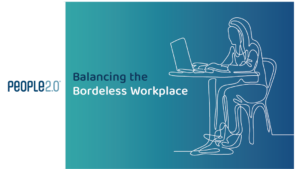Employee Wants, Company Needs: Balancing the Borderless Workplace
The post-pandemic workplace, coupled with the Great Resignation, has altered the employment landscape. Employees enjoyed greater flexibility during the pandemic. As the world settled back into normal routines, companies found employees weren’t as happy to go back to the way things were.
Gartner predicted that by 2021, 32% of the 628 million employees worldwide would be remote employees. As the demand for flexibility continues to increase, traditional workplaces are becoming less prevalent. Hybrid offices, remote employees, and independent contractors are growing in popularity.
ManpowerGroup Solutions found that many companies “struggle with entrenched company cultures that emphasize presenteeism and unknowingly cultivate flexibility stigma.” An unfortunate side effect of this stigma is that success is based on attendance rather than performance, quality of work, or produced outcomes. With 95% of knowledge workers wanting a flexible schedule, there is a significant gap in what employees and companies want.
The evidence suggests that remote employees, employees that have location flexibility in a hybrid office, and employees with time flexibility feel they have achieved greater productivity with flexible work arrangements. Gartner’s 2021 Digital Work Experience Survey found that 43% of the 10,000 respondents believed flexibility in their hours helped them to achieve greater productivity. Additionally, 30% of respondents felt the time saved by eliminating their commute enabled more productivity.
Employees want flexibility. Companies want productivity. Is there a way for both parties to get what they want? The answer is a resounding, “Yes!”
The Struggle for Workplace Balance: Remote Workplace? In-Office? Hybrid Office? 1099 Employees?
Employee wants and company needs don’t have to be incompatible. Companies that offer flexible work arrangements and greater autonomy for employees are seeing increases in retention, employee productivity, and overall employee satisfaction. Candidates who are willing to explore both permanent work opportunities or independent contractor opportunities are seeing gains as well.
A recent Future Forum survey found that 95% of those surveyed wanted flexible hours, while 78% wanted location flexibility. Workers that weren’t happy with their level of flexibility were more likely to seek new employment within the next year.
Companies have a greater chance of retaining valuable staff members if they allow for remote work, hybrid office structures, or flexible schedules. They also have a better chance of attracting new talent with flexible work arrangements. CareerBuilder found that jobs allowing remote work received seven times more applications. Distributed workforces, which employ mostly remote employees or independent contractors, allow companies to seek the best talent regardless of location.
If the Great Resignation proved anything, it is that employees are more than willing to walk away from a company if they feel their needs aren’t being met. Remote work opportunities, whether fully remote or hybrid office arrangements are what they need. Unfortunately, many employers are adamant that their workforce return to full-time office work.
Entrenched company cultures play a part in these decisions. But, it is becoming increasingly clear that hybrid work environments benefit both employer and employee in many cases. Gallup compiled decades of research and found that highly engaged workplaces claim 41% lower absenteeism, 40% fewer quality defects, and 21% higher profitability. Their research showed that engagement climbs when flexible work arrangements are available. Hybrid offices increased engagement significantly and the optimal engagement boost occurred when employees spent 60% to 80% of their time working remotely.
Staffing shortages are industry-agnostic at the moment. Most employers are under the impression that salary is still the driving factor for employment decisions. Workplace flexibility is quickly becoming a critical factor in whether someone accepts an offer of employment. In a recent hybrid working study surveying over 5,000 knowledge workers, 59% of respondents reported flexibility was more important than salary or other benefits. 77% said they would prefer to work for a company that provided location flexibility, while 59% said they would not work for a company that required them to be in-office five days per week.
Rising inflation and increasing commute costs are factors for many seeking remote work or hybrid office environments. One worker found that the cost of their commute was over a quarter of their daily earnings. In addition to location flexibility, employees are looking at their net pay. Some employers are even offering financial incentives to help combat the cost of commuting to the office in an attempt to eliminate remote work or hybrid office situations.
Autonomy also matters to many. Schedule flexibility is a top-three factor when making career decisions for 40% of global candidates surveyed by ManPower Solutions. Flexible schedules provide autonomy and create happier employees, as they can create a schedule that benefits their physical and mental health.
Finding a balance that works for both employee and employer can be difficult, but it can be done. It isn’t just the employees looking for more flexibility. Today’s economy demands a more flexible workforce.
Don’t get left behind in the changing World of Work. Start Empowering Flexible Workforces Worldwide.
People2.0 Announces Flexible Work Program
Here at People.2.0, we found that balancing employee wants with company needs was simple. With a distributed workforce, we were already accustomed to accommodating multiple time zones. The forced remote work of the pandemic made remote employees the new normal. Allowing location flexibility was a viable and valuable arrangement for employees and People2.0 when both the employee and their job were suited to remote or hybrid work.
Our Flexible Work Program allows employees the location flexibility they desire. Remote employees can work from home (WFH), in a satellite office, or as they travel for all or part of their workweek. Advancing technology has fundamentally changed the way we work and made remote work a possibility for many employees. Workers can easily stay connected via video conferencing and instant communication platforms.
As a distributed workforce, we need a global framework with regional considerations. That is just one of the reasons People2.0 doesn’t believe in the “one-size-fits-all” model. Instead of a blanket policy, People2.0 examines key factors before making a decision: role, customer interactions, team member interactions, and access to resources.
How to Create a Flexible Work Program
Peope2.0 has successfully deployed the Flexible Work Program and is already seeing results for both employees and employers. You too can create a flexible work program that suits the needs of your company and the evolving needs of your employees.
Here is how we formalized the Flexible Work Program:
We Asked Employees What They Wanted
Don’t make assumptions about what employees want. Ask. Surveys are an excellent way to quantify interest in this type of program within your organization. There are other items for consideration, though, so you will want to mix surveys with some focus groups. This will allow for a deeper understanding of managerial concerns and what factors employees consider when making this decision.
We Consulted the Data
The data you compile from your surveys and focus groups will help to guide and support your decision-making during this process. The information may not be clear and straightforward, so some analysis will be required to ensure you’re extracting the right information.
We Planned Our Policy
The best place to start is with your overall goals. Why are you considering a flexible work program and who will benefit from it? Then, you’ll want to consider your company’s needs. Do you need to hire remote employees? Are you looking for independent contractors or permanent employees? Will this be a distributed workforce? And how many time zones will you need to accommodate?
Once you’ve determined your goals and needs, it is time to set expectations. Working hours, number and frequency of meetings, communication expectations, equipment requirements, and more will need to be considered and determined.
You will also need to consider how to end a remote work arrangement. How would the decision be made to end the work from home (WFH) arrangement? What factors would allow an employee or manager to end the arrangement? What would the transition period look like?
We Implemented Our Policy
Once we developed a policy that was flexible enough to work for all parties but maintained enough boundaries that employers still felt comfortable, we moved on to the next step in the process. We developed resources like FAQs, tools, tips for working remotely, and management resources to ensure employee compliance.
We then updated our security policy. Cyber attacks are growing in frequency and remote workers need to be vigilant. Each remote access point is another way for those with malicious intent to enter the system. Proper training is essential, and the security policy should be updated to ensure remote device management control.
We Evaluated the Policy and Optimized
Employee feedback is essential to the evaluation process. So, be sure to set an evaluation timeline to ensure employees understand when to provide feedback and when they can expect changes to be made and implemented.
People2.0 offers a Flexible Work Program with positions open worldwide. Join the company empowering the global talent ecosystem. Visit People2.0 Careers today!



